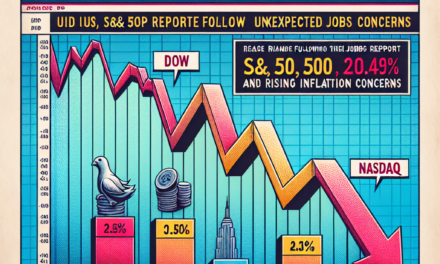“Bitcoin’s Bullish Surge: A New Rally on the Horizon!”
Introduction
Bitcoin’s bullish indicators are increasingly capturing the attention of investors and analysts, signaling the potential for a new rally in the cryptocurrency market. As the digital asset continues to mature, a confluence of technical and fundamental factors is emerging, suggesting a positive outlook for its price trajectory. Key indicators such as increased institutional adoption, favorable regulatory developments, and robust on-chain metrics are contributing to a growing sense of optimism. Additionally, technical analysis points to strong support levels and bullish chart patterns, further reinforcing the possibility of an upward trend. As these elements align, market participants are closely monitoring Bitcoin’s performance, anticipating a potential resurgence that could redefine its position in the financial landscape.
Historical Patterns: Analyzing Past Bitcoin Bull Runs
Bitcoin, the pioneering cryptocurrency, has long been a subject of fascination and speculation among investors and analysts alike. As the digital asset continues to mature, understanding its historical patterns becomes crucial for predicting future movements. Analyzing past Bitcoin bull runs provides valuable insights into the potential for new rallies, as certain indicators often precede significant price increases. By examining these historical trends, investors can better position themselves to capitalize on future opportunities.
To begin with, it is essential to recognize that Bitcoin’s price history is characterized by a series of dramatic bull runs followed by corrections. These cycles are often driven by a combination of technological advancements, regulatory developments, and macroeconomic factors. For instance, the 2013 bull run was largely fueled by increased media attention and the growing acceptance of Bitcoin as a legitimate form of payment. Similarly, the 2017 rally was driven by a surge in retail investor interest and the introduction of Bitcoin futures trading, which provided a new avenue for institutional investment.
One of the most notable patterns observed in past bull runs is the halving event, which occurs approximately every four years. This event reduces the reward for mining new blocks by half, effectively decreasing the rate at which new Bitcoin is introduced into circulation. Historically, halvings have been followed by significant price increases, as the reduced supply coupled with sustained demand creates upward pressure on prices. The 2012 and 2016 halvings, for example, were both followed by substantial bull runs, suggesting that this pattern may hold true for future halvings as well.
In addition to the halving events, another key indicator of potential bull runs is the increasing adoption of Bitcoin by both retail and institutional investors. As more individuals and organizations recognize the value of Bitcoin as a store of value and a hedge against inflation, demand for the digital asset is likely to increase. This growing acceptance is evidenced by the increasing number of companies that now accept Bitcoin as a form of payment, as well as the rise of Bitcoin-focused investment products such as exchange-traded funds (ETFs) and trusts.
Moreover, macroeconomic factors play a significant role in shaping Bitcoin’s price movements. In times of economic uncertainty, investors often seek alternative assets to protect their wealth, and Bitcoin has increasingly been viewed as a viable option. For instance, during periods of high inflation or geopolitical tensions, Bitcoin’s decentralized nature and limited supply make it an attractive hedge against traditional financial systems. This trend was particularly evident during the COVID-19 pandemic, when unprecedented monetary stimulus measures led to concerns about currency devaluation and spurred interest in Bitcoin as a safe haven asset.
Furthermore, technological advancements within the Bitcoin ecosystem can also serve as catalysts for bull runs. Developments such as the implementation of the Lightning Network, which aims to improve transaction speed and scalability, and the growing interest in decentralized finance (DeFi) applications built on the Bitcoin blockchain, have the potential to drive increased adoption and, consequently, price appreciation.
In conclusion, while predicting the exact timing and magnitude of future Bitcoin bull runs remains challenging, analyzing historical patterns provides valuable insights into potential indicators of new rallies. By considering factors such as halving events, increasing adoption, macroeconomic conditions, and technological advancements, investors can better understand the dynamics that drive Bitcoin’s price movements and position themselves to take advantage of future opportunities. As the cryptocurrency market continues to evolve, staying informed about these historical patterns will be crucial for navigating the ever-changing landscape of digital assets.
On-Chain Metrics: Key Indicators of Bitcoin’s Bullish Momentum
Bitcoin’s recent market activity has captured the attention of investors and analysts alike, as several on-chain metrics suggest the potential for a new bullish rally. These indicators, which provide insights into the underlying health and momentum of the Bitcoin network, are crucial for understanding the cryptocurrency’s future price movements. As we delve into these metrics, it becomes evident that Bitcoin’s current trajectory may be setting the stage for a significant upward trend.
One of the primary on-chain metrics signaling bullish momentum is the increasing number of active addresses. This metric reflects the number of unique addresses participating in transactions on the Bitcoin network. A rising number of active addresses typically indicates growing interest and engagement from users, suggesting that more participants are entering the market. This heightened activity often correlates with increased demand, which can drive prices higher. Furthermore, the sustained growth in active addresses over recent weeks underscores a robust network effect, reinforcing Bitcoin’s position as a leading digital asset.
In addition to active addresses, the volume of Bitcoin transactions is another critical indicator of market sentiment. An uptick in transaction volume often signifies heightened trading activity and liquidity, both of which are essential for a healthy market. Recent data shows a notable increase in transaction volume, suggesting that investors are actively buying and selling Bitcoin. This surge in activity can be interpreted as a sign of confidence in the asset, as market participants are willing to engage at current price levels. Consequently, this increased liquidity can provide the necessary support for a potential price rally.
Moreover, the accumulation trend among long-term holders is a compelling factor contributing to Bitcoin’s bullish outlook. Long-term holders, often referred to as “HODLers,” are individuals or entities that retain their Bitcoin holdings for extended periods, typically with the expectation of future price appreciation. When these holders begin to accumulate more Bitcoin, it indicates a strong belief in the asset’s long-term value. Recent on-chain data reveals that long-term holders have been steadily increasing their positions, suggesting that they anticipate further price gains. This accumulation behavior can reduce the available supply of Bitcoin on exchanges, creating upward pressure on prices.
Another noteworthy metric is the declining balance of Bitcoin on exchanges. When Bitcoin is withdrawn from exchanges and moved to private wallets, it often signifies that investors are opting to hold their assets rather than sell them. This trend can lead to a supply squeeze, as fewer coins are available for trading on exchanges. The current decrease in exchange balances aligns with the accumulation trend observed among long-term holders, further supporting the case for a potential price rally.
Finally, the network’s hash rate, which measures the computational power dedicated to mining Bitcoin, has been on an upward trajectory. A rising hash rate indicates increased confidence among miners, as they invest more resources into securing the network. This investment is often driven by expectations of future profitability, suggesting that miners anticipate higher Bitcoin prices. The combination of a robust hash rate and other bullish on-chain metrics paints a positive picture for Bitcoin’s near-term prospects.
In conclusion, the convergence of these on-chain metrics—rising active addresses, increased transaction volume, accumulation by long-term holders, declining exchange balances, and a growing hash rate—suggests that Bitcoin is poised for a potential new rally. While market conditions can change rapidly, these indicators provide valuable insights into the underlying dynamics of the Bitcoin network, offering a glimpse into the cryptocurrency’s future trajectory. As investors continue to monitor these metrics, the anticipation of a bullish rally remains palpable, underscoring the enduring allure of Bitcoin in the ever-evolving digital asset landscape.
Institutional Investment: The Role of Big Players in Bitcoin’s Price Surge
In recent years, Bitcoin has emerged as a formidable asset in the financial markets, capturing the attention of both individual investors and institutional players. The cryptocurrency’s potential for high returns has made it an attractive option for those seeking to diversify their portfolios. As Bitcoin’s price continues to exhibit bullish indicators, the role of institutional investment becomes increasingly significant in understanding the dynamics behind its potential new rally.
Institutional investors, including hedge funds, asset managers, and publicly traded companies, have been gradually increasing their exposure to Bitcoin. This trend is not only a testament to the growing acceptance of cryptocurrencies as a legitimate asset class but also a reflection of the strategic shift in investment strategies. The involvement of these big players has brought a level of credibility and stability to the market, which was once considered highly volatile and speculative. Consequently, their participation has contributed to the upward momentum in Bitcoin’s price.
One of the primary reasons institutional investors are drawn to Bitcoin is its potential as a hedge against inflation. In an era of unprecedented monetary policy and fiscal stimulus, concerns about currency devaluation have prompted investors to seek alternative stores of value. Bitcoin, with its capped supply of 21 million coins, offers a unique proposition as a deflationary asset. This characteristic has resonated with institutions looking to protect their portfolios from the erosive effects of inflation, thereby driving demand and contributing to price appreciation.
Moreover, the infrastructure supporting Bitcoin investment has matured significantly, making it more accessible and appealing to institutional investors. The development of regulated exchanges, custodial services, and financial products such as Bitcoin futures and exchange-traded funds (ETFs) has facilitated institutional entry into the market. These advancements have addressed previous concerns regarding security, liquidity, and regulatory compliance, thereby reducing the perceived risks associated with Bitcoin investment.
In addition to these factors, the increasing integration of Bitcoin into the traditional financial system has further bolstered institutional interest. Major financial institutions, including banks and payment processors, have begun to offer Bitcoin-related services, signaling a broader acceptance of the cryptocurrency. This integration not only enhances Bitcoin’s legitimacy but also provides institutional investors with more avenues to gain exposure to the asset, thereby amplifying its price dynamics.
Furthermore, the influence of institutional investment on Bitcoin’s price is not limited to direct purchases. The strategic decisions made by these investors can have a ripple effect throughout the market. For instance, when a prominent institution publicly announces its investment in Bitcoin, it can trigger a wave of buying activity from other investors, both institutional and retail. This phenomenon, often referred to as the “institutional endorsement effect,” can lead to significant price surges, as market participants interpret such moves as a vote of confidence in Bitcoin’s long-term prospects.
In conclusion, the role of institutional investment in Bitcoin’s price surge cannot be overstated. As these big players continue to allocate capital to the cryptocurrency, they not only drive demand but also contribute to the maturation and stabilization of the market. With bullish indicators suggesting the potential for a new rally, the influence of institutional investors is likely to remain a key factor in shaping Bitcoin’s trajectory. As the landscape of digital assets continues to evolve, the interplay between institutional investment and Bitcoin’s price dynamics will undoubtedly be a focal point for market observers and participants alike.
Market Sentiment: How Positive News Drives Bitcoin’s Rally

Bitcoin’s market dynamics have always been a subject of intense scrutiny, with investors and analysts alike constantly seeking indicators that might signal the next big move. Recently, a confluence of positive news and market sentiment has emerged, suggesting the potential for a new rally in Bitcoin’s price. Understanding how these factors interplay is crucial for anyone looking to navigate the volatile waters of cryptocurrency investment.
To begin with, the role of market sentiment in driving Bitcoin’s price cannot be overstated. Unlike traditional financial markets, where fundamentals such as earnings reports and economic indicators play a significant role, the cryptocurrency market is heavily influenced by investor sentiment. This sentiment is often shaped by news events, regulatory developments, and macroeconomic trends. For instance, when major financial institutions announce their entry into the cryptocurrency space, it often leads to a surge in positive sentiment, as it is perceived as a validation of Bitcoin’s legitimacy and potential for mainstream adoption.
Moreover, recent developments have provided a fertile ground for optimism. The approval of Bitcoin exchange-traded funds (ETFs) in several jurisdictions has been a significant milestone. These financial instruments offer a more accessible way for institutional and retail investors to gain exposure to Bitcoin without the complexities of direct ownership. The anticipation and subsequent approval of these ETFs have historically led to increased buying pressure, as they open the floodgates for a new wave of capital inflow into the market.
In addition to institutional interest, macroeconomic factors are also playing a pivotal role in shaping market sentiment. With inflationary pressures mounting globally, Bitcoin is increasingly being viewed as a hedge against currency devaluation. This narrative has gained traction, particularly in regions experiencing economic instability, where traditional financial systems are under strain. As a result, Bitcoin’s appeal as a store of value is resonating with a broader audience, further bolstering positive sentiment.
Furthermore, technological advancements within the Bitcoin ecosystem are contributing to the bullish outlook. The implementation of the Lightning Network, which aims to enhance Bitcoin’s scalability and transaction speed, is a prime example. Such developments not only improve the functionality of the network but also instill confidence among users and investors regarding Bitcoin’s long-term viability. As these technological improvements gain traction, they are likely to attract more users and investors, thereby driving demand and potentially leading to price appreciation.
However, it is important to acknowledge that while positive news and sentiment can drive rallies, they also contribute to heightened volatility. The cryptocurrency market is notorious for its rapid price swings, and investor sentiment can shift quickly in response to new information. Therefore, while the current indicators are bullish, investors should remain vigilant and consider the inherent risks associated with cryptocurrency investments.
In conclusion, the interplay between positive news, market sentiment, and Bitcoin’s price dynamics is complex yet fascinating. The recent wave of bullish indicators, driven by institutional interest, macroeconomic factors, and technological advancements, suggests the potential for a new rally. However, as with any investment, it is essential to approach the market with a balanced perspective, recognizing both the opportunities and risks that lie ahead. As Bitcoin continues to evolve, staying informed and adaptable will be key to navigating its ever-changing landscape.
Technical Analysis: Chart Patterns Signaling Bitcoin’s Uptrend
Bitcoin’s recent market movements have captured the attention of investors and analysts alike, as several technical indicators suggest the potential for a new bullish rally. As the cryptocurrency market continues to evolve, understanding these indicators becomes crucial for those looking to capitalize on potential upward trends. In recent weeks, Bitcoin has demonstrated a series of chart patterns that are traditionally associated with bullish momentum, providing a foundation for optimism among traders.
One of the most prominent indicators currently observed is the ascending triangle pattern. This pattern, characterized by a horizontal resistance line and an upward sloping support line, often signals a continuation of an uptrend. As Bitcoin’s price consolidates within this formation, the pressure builds for a potential breakout above the resistance level. Historically, when Bitcoin has broken out of an ascending triangle, it has often led to significant price increases, suggesting that a similar outcome could be on the horizon.
In addition to the ascending triangle, the moving averages are also painting a positive picture for Bitcoin. The 50-day moving average has recently crossed above the 200-day moving average, forming what is known as a “golden cross.” This event is widely regarded as a bullish signal, indicating that the short-term price momentum is outpacing the long-term trend. The golden cross has been a reliable indicator in the past, often preceding substantial price rallies in Bitcoin’s history.
Moreover, the Relative Strength Index (RSI), a momentum oscillator that measures the speed and change of price movements, is currently positioned in a favorable range. The RSI has been hovering around the 50-70 range, suggesting that Bitcoin is neither overbought nor oversold. This balanced position provides room for upward movement without the immediate risk of a sharp correction, further supporting the potential for a sustained rally.
Furthermore, on-chain data adds another layer of bullish sentiment to the current analysis. The number of active Bitcoin addresses has been steadily increasing, indicating growing interest and participation in the network. This rise in activity often correlates with increased demand, which can drive prices higher. Additionally, the amount of Bitcoin held on exchanges has been decreasing, suggesting that investors are moving their holdings to long-term storage, a behavior typically associated with expectations of future price appreciation.
While these technical indicators and on-chain metrics provide a compelling case for a potential Bitcoin rally, it is essential to consider the broader market context. Macroeconomic factors, regulatory developments, and investor sentiment can all influence Bitcoin’s price trajectory. However, the convergence of these bullish indicators suggests that Bitcoin is well-positioned for an upward move, provided that external conditions remain supportive.
In conclusion, Bitcoin’s current technical landscape is marked by several bullish indicators, including the ascending triangle pattern, the golden cross, and favorable RSI levels. Coupled with positive on-chain data, these factors signal the potential for a new rally in Bitcoin’s price. As always, investors should remain vigilant and consider a comprehensive approach that includes both technical analysis and an understanding of broader market dynamics. By doing so, they can better navigate the complexities of the cryptocurrency market and make informed decisions in anticipation of potential price movements.
Supply Dynamics: The Impact of Bitcoin Halving on Price Movements
Bitcoin’s supply dynamics have long been a focal point for investors and analysts seeking to understand its price movements. Central to this discussion is the phenomenon known as Bitcoin halving, an event that occurs approximately every four years, reducing the reward miners receive for adding a new block to the blockchain by half. This mechanism, embedded in Bitcoin’s protocol, is designed to control inflation and ensure a finite supply of 21 million coins. As the next halving approaches, many are speculating about its potential impact on Bitcoin’s price, with bullish indicators suggesting the possibility of a new rally.
To comprehend the implications of Bitcoin halving, it is essential to consider the basic economic principle of supply and demand. By reducing the rate at which new bitcoins are introduced into circulation, halving events effectively decrease the supply of new coins. Assuming demand remains constant or increases, this reduction in supply can exert upward pressure on prices. Historical data supports this theory, as previous halvings in 2012, 2016, and 2020 have been followed by significant price increases, albeit with varying time lags.
Moreover, the anticipation of a halving event often generates increased interest and speculation within the cryptocurrency market. Investors, aware of the potential for price appreciation, may begin accumulating Bitcoin in advance, further driving up demand. This pre-halving accumulation can create a self-fulfilling prophecy, where the expectation of higher prices leads to actual price increases. Consequently, the market sentiment surrounding halving events tends to be overwhelmingly positive, contributing to the bullish indicators currently observed.
In addition to the direct impact on supply, Bitcoin halving also influences the mining ecosystem. As the reward for mining diminishes, less efficient miners may find it unprofitable to continue operations, leading to a consolidation of mining power among more efficient players. This shift can enhance the network’s security and stability, as larger, more established miners are better equipped to withstand market fluctuations. Furthermore, the increased competition among miners can drive technological advancements and efficiency improvements, benefiting the overall Bitcoin network.
While the supply-side effects of halving are significant, it is crucial to acknowledge the role of external factors in shaping Bitcoin’s price trajectory. Macroeconomic conditions, regulatory developments, and technological innovations all play a part in influencing investor sentiment and market dynamics. For instance, growing institutional interest in Bitcoin as a hedge against inflation and economic uncertainty has bolstered its appeal as a store of value. Similarly, advancements in blockchain technology and the proliferation of decentralized finance (DeFi) applications have expanded Bitcoin’s use cases, attracting a broader range of investors.
In conclusion, the upcoming Bitcoin halving presents a compelling case for a potential new rally, driven by the interplay of supply dynamics and market sentiment. While historical patterns suggest a bullish outlook, it is essential to remain cognizant of the myriad factors that can influence Bitcoin’s price movements. As the cryptocurrency landscape continues to evolve, investors must stay informed and adaptable, recognizing that while halving events are significant, they are but one piece of the complex puzzle that is Bitcoin’s market behavior.
Regulatory Developments: How Legal Clarity Fuels Bitcoin’s Growth
Bitcoin’s recent bullish indicators have sparked discussions about a potential new rally, with regulatory developments playing a crucial role in this anticipated growth. As the cryptocurrency market matures, the need for legal clarity becomes increasingly apparent, and recent regulatory advancements have provided a more stable foundation for Bitcoin’s expansion. This newfound clarity is not only fostering investor confidence but also encouraging institutional participation, which could significantly impact Bitcoin’s trajectory.
To begin with, regulatory clarity helps mitigate the uncertainties that have historically plagued the cryptocurrency market. In the past, the lack of clear guidelines often led to market volatility, as investors were unsure about the legal status of their holdings. However, recent efforts by governments and regulatory bodies to establish comprehensive frameworks have begun to address these concerns. For instance, the United States Securities and Exchange Commission (SEC) has been actively working on providing clearer guidelines for cryptocurrency exchanges and initial coin offerings (ICOs). This proactive approach is gradually dispelling the ambiguity that once surrounded Bitcoin and other digital assets.
Moreover, the introduction of regulatory measures has paved the way for greater institutional involvement in the cryptocurrency space. Institutional investors, such as hedge funds and asset management firms, have traditionally been wary of entering a market perceived as the “Wild West” due to its lack of regulation. However, as legal frameworks become more defined, these entities are increasingly viewing Bitcoin as a viable investment option. The entry of institutional capital not only brings substantial liquidity to the market but also lends credibility to Bitcoin as a legitimate asset class. This shift in perception is crucial for Bitcoin’s long-term growth, as it attracts a broader range of investors and reduces the market’s susceptibility to manipulation.
In addition to fostering institutional interest, regulatory clarity also facilitates the development of innovative financial products. With a clear legal framework in place, financial institutions are more inclined to create Bitcoin-related products, such as exchange-traded funds (ETFs) and futures contracts. These products provide investors with new avenues to gain exposure to Bitcoin, further integrating it into the traditional financial system. The approval of Bitcoin ETFs, in particular, has been a significant milestone, as it allows investors to trade Bitcoin on regulated exchanges, thereby increasing accessibility and reducing the risks associated with direct cryptocurrency ownership.
Furthermore, regulatory developments have encouraged the adoption of Bitcoin by mainstream businesses. Companies are now more willing to accept Bitcoin as a form of payment, knowing that they are operating within a defined legal framework. This increased acceptance not only enhances Bitcoin’s utility as a medium of exchange but also contributes to its overall demand. As more businesses integrate Bitcoin into their operations, the network effect strengthens, potentially driving up its value.
In conclusion, the regulatory landscape surrounding Bitcoin is evolving, and this evolution is proving to be a catalyst for its growth. By providing legal clarity, regulatory developments are reducing market uncertainties, attracting institutional investors, enabling the creation of innovative financial products, and encouraging mainstream adoption. These factors collectively signal a positive outlook for Bitcoin, suggesting that the current bullish indicators may indeed herald a new rally. As the cryptocurrency market continues to mature, the role of regulation will remain pivotal in shaping Bitcoin’s future trajectory, ensuring its stability and fostering sustainable growth.
Q&A
1. **What is a bullish indicator for Bitcoin?**
A bullish indicator for Bitcoin could be a technical pattern such as a “golden cross,” where the 50-day moving average crosses above the 200-day moving average, suggesting potential upward momentum.
2. **How does trading volume affect Bitcoin’s bullish outlook?**
Increased trading volume during price increases can signal strong market interest and support for a bullish trend, indicating potential for a sustained rally.
3. **What role does investor sentiment play in Bitcoin’s bullish indicators?**
Positive investor sentiment, often measured by metrics like the Fear & Greed Index, can indicate increased confidence and potential for a bullish market trend.
4. **How do institutional investments impact Bitcoin’s bullish potential?**
Institutional investments can provide significant capital inflows and legitimacy, often seen as a bullish indicator due to increased market confidence and stability.
5. **What is the significance of Bitcoin’s halving events in bullish trends?**
Bitcoin halving events reduce the reward for mining new blocks, decreasing supply and historically leading to increased prices, often seen as a bullish indicator.
6. **How do macroeconomic factors influence Bitcoin’s bullish indicators?**
Factors like inflation, currency devaluation, or economic instability can drive investors to seek Bitcoin as a hedge, potentially signaling a bullish trend.
7. **What is the impact of regulatory news on Bitcoin’s bullish indicators?**
Positive regulatory news, such as the approval of Bitcoin ETFs, can enhance market confidence and attract new investors, often seen as a bullish signal.
Conclusion
Bitcoin’s recent market activity has shown several bullish indicators that suggest the potential for a new rally. Key factors include increased institutional interest, as evidenced by rising investment in Bitcoin-related financial products and growing adoption by major corporations. Additionally, on-chain metrics such as rising hash rates and decreasing Bitcoin reserves on exchanges indicate strong network security and reduced selling pressure, respectively. Technical analysis also points to bullish patterns, with Bitcoin breaking through significant resistance levels and maintaining upward momentum. Furthermore, macroeconomic conditions, such as inflation concerns and currency devaluation, continue to drive interest in Bitcoin as a hedge. These combined factors create a favorable environment for a potential new rally in Bitcoin’s price.





